Interview by Romily Alice Walden // Nov. 27, 2018
Baby Punk + Dr. Babuyoka collaborate in a multidisciplinary live performance that fuses rap, video, hip hop and spiritual ritual. During their performance, video footage of conspiracy theorists and sea creatures is spliced together with documentary from Baby Punk’s monthly medical procedures; this loops on screen while Baby Punk pisses wine into cardboard bed pans, raps over Dr. Babuyoka’s live beats and crawls on the floor coughing up blood. The two create a challenging and magnificent mess. The work forces an audience to reframe disability, queerness, sex and pain as complex and interwoven facets of the human experience; their performance positions crip, alien and othered bodies as joyful, political, sexy and angry. Berlin Art Link sat down with Baby Punk + Dr. Babuyoka to talk about their creation.
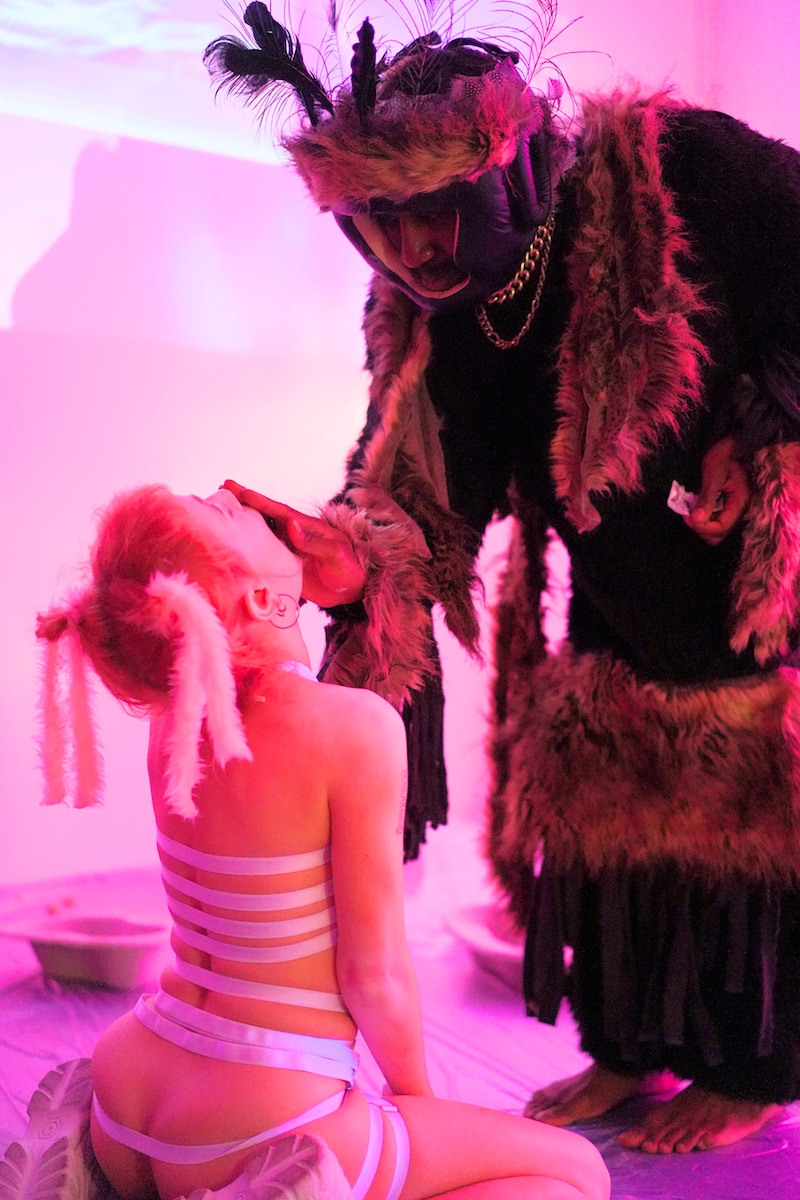
Baby Punk + Dr. Babuyoka, performance at ‘LUCKY’ curated by Coven at nGbK Berlin // Photo by Abs Hale
Romily Alice Walden: How did the performance develop and how do you describe it for those who haven’t seen it?
Dr. Babuyoka: The performance was developed in the Doctor’s lab aka my bedroom. We are Baby Punk + Dr. Babuyoka and we grew through experimenting with psychedelic drugs, which was a part of opening us to each other and ourselves.
Baby Punk: I shared with the Doctor that I lost my voice for over a year due to disability. The doctor prescribed using my voice to express myself. This was an alien thing for me as I usually make video art. We then started thinking about this work as an expression of self and shared interests, music and esoteric shit.
Dr. B: The performance consists of two alien monsters that combine live experimental sound, hip hop and techno with spiritualistic ritual elements to create an immersive experience.
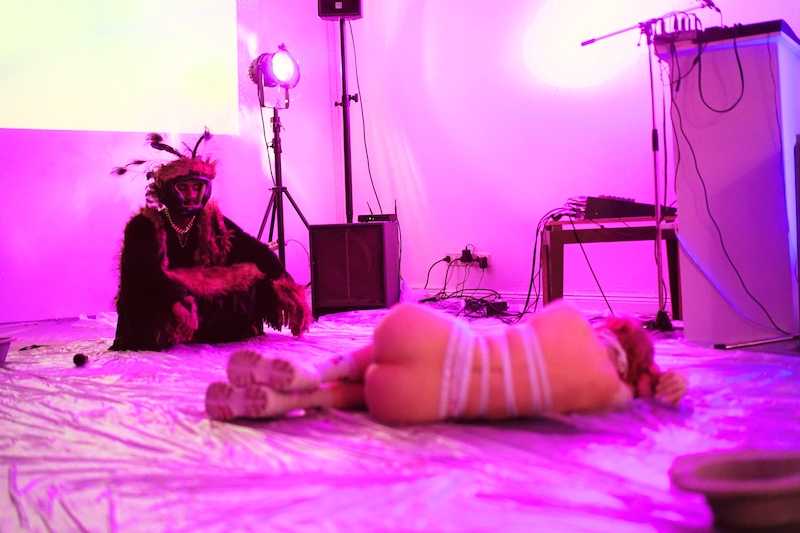
Baby Punk + Dr. Babuyoka, performance at ‘LUCKY’ curated by Coven at nGbK Berlin // Photo by Abs Hale
RAW: The work speaks to so many intersections of identity that are ‘othered’ within our society. How does Baby Punk + Dr. Babuyoka relate to the idea of the alien or the other?
Dr. B: I have never felt more alien than I have since moving to Berlin. Landing in a foreign country makes me alien; it is a different environment compared to London and with Germany being very white, my race has been made more noticeable than before. When travelling across Europe to neighbouring countries I realised that this is an issue that is not specific to Berlin or Germany. The urge to remove race from my character and become a true creature was important so that people would look beyond a “black face.”
BP: I live outside the system and can’t afford health insurance in Berlin, which isn’t legal as insurance is mandatory here. I have had to find ways to get health care that aren’t traditional. My disabilities are invisible and I want to find a way of making my experience of cripness visible. I want to challenge preconceptions of what it is to be disabled, which commonly includes the idea that disabled people shouldn’t have joy in their lives, don’t have sex, party or engage in activities that are deemed ‘unhealthy’ by able-bodied people. I want to celebrate my sickness as a political act.
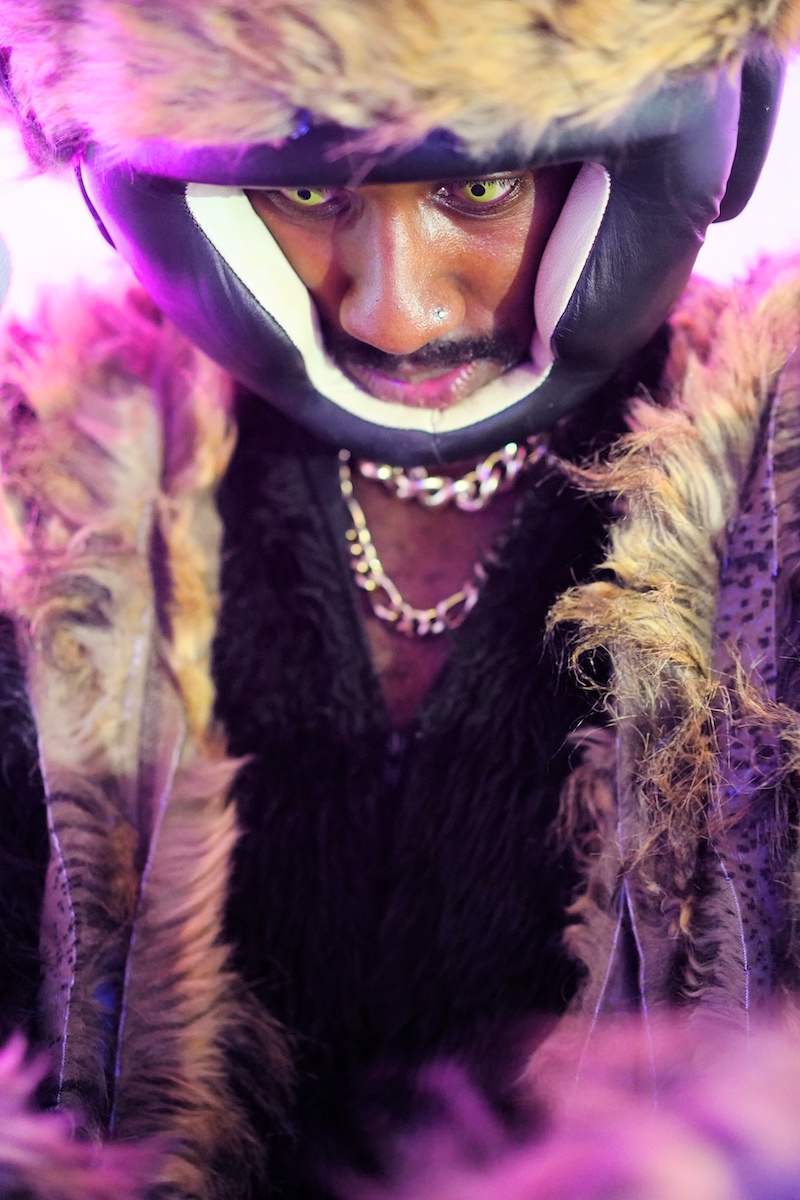
Baby Punk + Dr. Babuyoka, performance at ‘LUCKY’ curated by Coven at nGbK Berlin // Photo by Abs Hale
RAW: Mainstream Euro-North American culture views disabled bodies as private bodies: bodies that should be kept hidden in private spaces (sick beds, hospitals, institutions, etc.). But Baby Punk + Dr. Babuyoka brings your crip experience into a space where people are forced to confront the body and its fallibility. Can you talk about the effect this confrontation has had on you as a disabled artist and as a collaborative team?
BP: I hate the fact that in western cultures, crip bodies and anything related to sickness and bodily functions carry a lot of shame. I want to challenge that perception by using performative techniques of shock and humour to confront the fear around making the crip experience visible. In a capitalist society, crip people are seen as less valuable than able-bodied people. We are perceived as something to be cured so we can achieve an ideal worker status. I spend a lot of time hiding my cripness; sharing it with the Doc in a supportive and creative environment has helped me to be more vocal about my own experience. It has also allowed me to connect with and support other crip people and artists. It has helped me develop a political stance surrounding how we as crip people are treated by society.
Dr. B: We have the shared experience that we aren’t able to get everything that we need out of the traditional health care system due to the restrictive way in which the system approaches health and care.
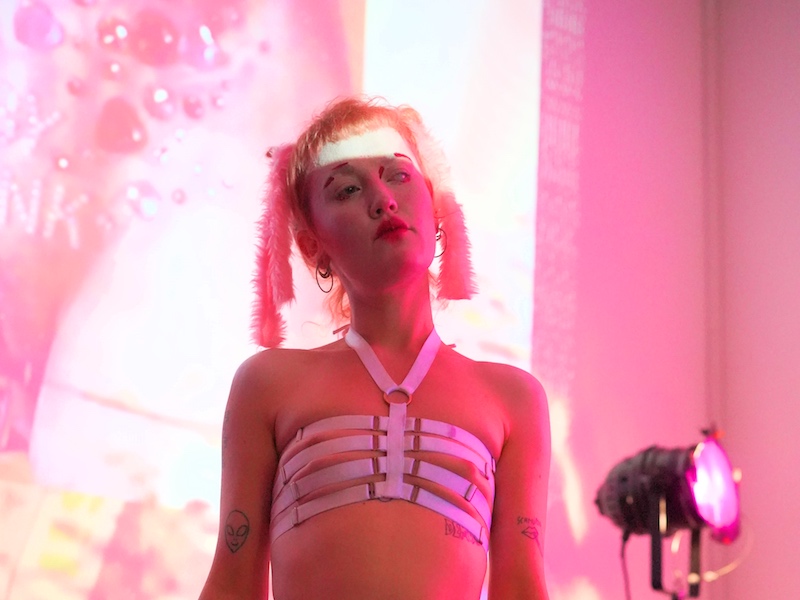
Baby Punk + Dr. Babuyoka, performance at ‘LUCKY’ curated by Coven at nGbK Berlin // Photo by Abs Hale
RAW: Can you tell us about your use of the word crip?
BP: I really like the term crip because it is an umbrella term that removes hierarchies within the sick and disabled community, for example; between invisible / visible disabilities and illnesses, as well as between mental / physical disabilities or illnesses. I like that the word has been reclaimed from the slur, cripple. There is a strong history of words that have been used in a derogatory way being reclaimed by the community they have been used against.
RAW: There seems to be a desire within your work to resist overly simplistic narratives surrounding sexuality, sickness and the body. Do you feel that these nuances are lost within normative discourse on the topics? Do you think that disability, queerness, sexuality and the erotic are seen as incompatible or in opposition to each other?
BP: I feel there is a discourse but it’s not talked about enough. The problem is all of these topics like sexuality, sickness and the body are all messy by nature and we have a tendency within western culture to want to compartmentalise and label these things in a clean way. This creates problematic binaries. Regarding sexuality and sickness, we either view it as being disgusting or it gets fetishised. People are either actively disgusted and believe crip people do not have sex, or it goes to the other extreme and people want to see amputee porn, for example. There is no expression or understanding of the lived experience, which is much more complex.
Crip people are always viewed as vulnerable or weak. The visuals we present try to give a fuller perspective of this experience, which can include strength, playfulness, anger, comfort and love as well as vulnerability and weakness. For example, the visuals include female UFC fighters, sea creatures and alien porn.
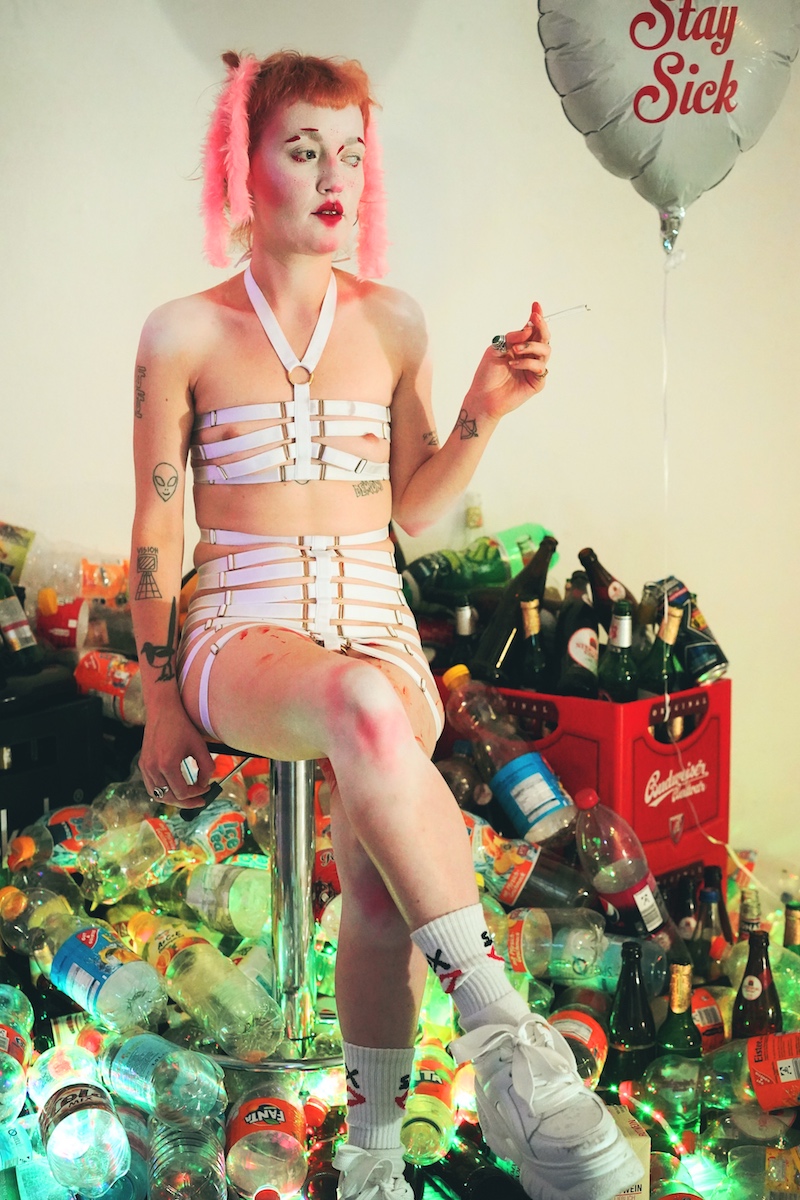
Baby Punk + Dr. Babuyoka, performance at ‘LUCKY’ curated by Coven at nGbK Berlin // Photo by Abs Hale
RAW: What does the relationship between Dr. Babuyoka and Baby Punk tell us about care and tenderness in the face of the medical-industrial complex?
BP: The relationship between us as people as well as performative characters is one of support; we have discovered that if you cannot get what you need from the traditional medical system, there are ways to create autonomous health care through listening, understanding and caring for each other.
Dr. B: Collective working is important to us both individually in our creative practices, it runs deeper than just collaborating and creating something together. The people we work with and share energy with are very important to us and we look to support each other beyond the art.
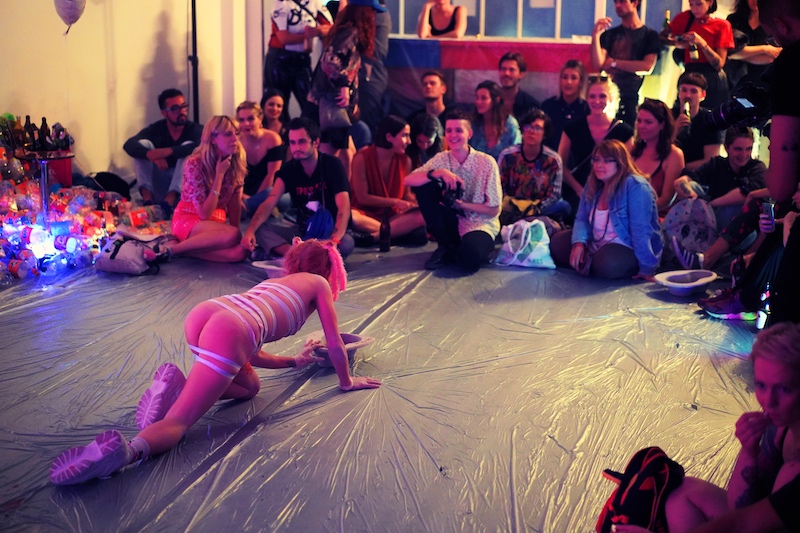
Baby Punk + Dr. Babuyoka, performance at ‘LUCKY’ curated by Coven at nGbK Berlin // Photo by Abs Hale
RAW: There is a trend within contemporary art to position rationality and clean aesthetics as the pinnacles of refined artistic expression. How have you found that audiences and institutions have reacted to the messiness and multidisciplinary nature of Baby Punk + Dr. Babuyoka? Does this reaction vary depending on if you’re performing in galleries, clubs or queer spaces?
BP: Even though we have received financial support and invitations to present the work in institutional settings we have been more welcomed and felt more comfortable presenting the work in less institutional spaces, such as squats and queer parties. At the same time, we enjoy pushing the boundaries of what is acceptable and expected within institutional environments.
Dr. B: Opening perceptions and boundaries is the premise of the work and so we hope that we get the opportunity to present it in more institutional spaces.
Artist Info
yonabout.hotglue.me
Baby Punk + Dr. Babuyoka is the work of artist Laura G. Jones and performer and musician Alexander Linton.



















